GMC Acadia 2015 Owner's Manual
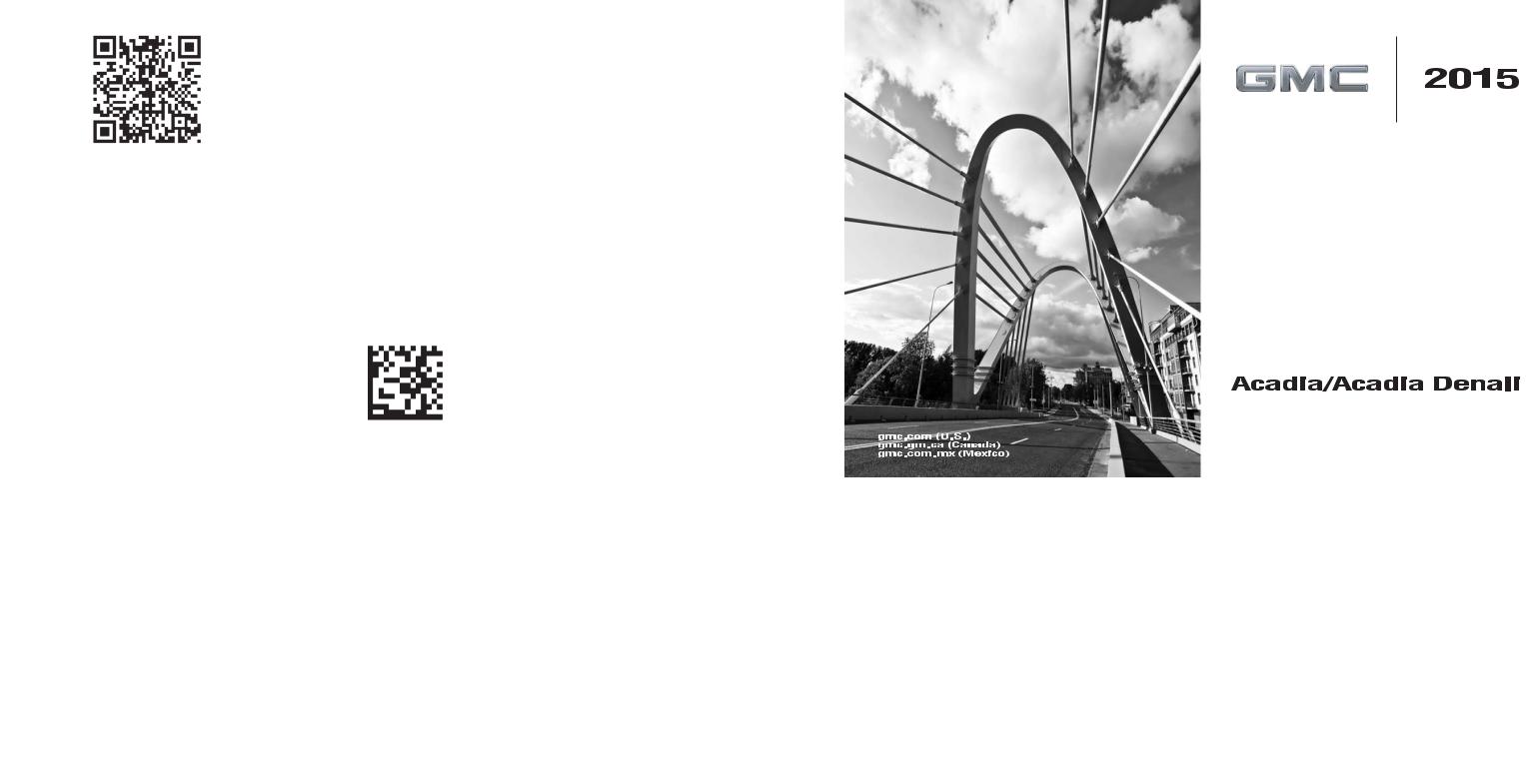

2015 GMC Acadia/Acadia Denali Owner Manual M
In Brief . . . . . . . . . . . . . . . . . . . . . . . . 1-1
Instrument Panel . . . . . . . . . . . . . . 1-2
Initial Drive Information . . . . . . . . 1-4
Vehicle Features . . . . . . . . . . . . . 1-16
Performance and
Maintenance . . . . . . . . . . . . . . . . 1-21
Keys, Doors, and
Windows . . . . . . . . . . . . . . . . . . . . 2-1
Keys and Locks . . . . . . . . . . . . . . . 2-1
Doors . . . . . . . . . . . . . . . . . . . . . . . . . . 2-8
Vehicle Security. . . . . . . . . . . . . . 2-11
Exterior Mirrors . . . . . . . . . . . . . . . 2-14
Interior Mirrors . . . . . . . . . . . . . . . . 2-16
Windows . . . . . . . . . . . . . . . . . . . . . 2-17
Roof . . . . . . . . . . . . . . . . . . . . . . . . . . 2-19
Seats and Restraints . . . . . . . . . 3-1
Head Restraints . . . . . . . . . . . . . . . 3-2
Front Seats . . . . . . . . . . . . . . . . . . . . 3-3
Rear Seats . . . . . . . . . . . . . . . . . . . . 3-9
Safety Belts . . . . . . . . . . . . . . . . . . 3-14
Airbag System . . . . . . . . . . . . . . . . 3-22
Child Restraints . . . . . . . . . . . . . . 3-36
Storage . . . . . . . . . . . . . . . . . . . . . . . 4-1
Storage Compartments . . . . . . . . 4-1
Additional Storage Features . . . 4-3
Roof Rack System . . . . . . . . . . . . . 4-4
Instruments and Controls . . . . 5-1
Controls . . . . . . . . . . . . . . . . . . . . . . . 5-2
Warning Lights, Gauges, and
Indicators . . . . . . . . . . . . . . . . . . . . 5-9
Information Displays . . . . . . . . . . 5-23
Vehicle Messages . . . . . . . . . . . . 5-32
Vehicle Personalization . . . . . . . 5-42
Universal Remote System . . . . 5-49
Lighting . . . . . . . . . . . . . . . . . . . . . . . 6-1
Exterior Lighting . . . . . . . . . . . . . . . 6-1
Interior Lighting . . . . . . . . . . . . . . . . 6-5
Lighting Features . . . . . . . . . . . . . . 6-6
Infotainment System . . . . . . . . . 7-1
Introduction . . . . . . . . . . . . . . . . . . . . 7-1
Radio . . . . . . . . . . . . . . . . . . . . . . . . . . 7-6
Audio Players . . . . . . . . . . . . . . . . 7-11
Rear Seat Infotainment . . . . . . . 7-16
Phone . . . . . . . . . . . . . . . . . . . . . . . . 7-18
Settings . . . . . . . . . . . . . . . . . . . . . . 7-25
Trademarks and License
Agreements . . . . . . . . . . . . . . . . . 7-27
Climate Controls . . . . . . . . . . . . . 8-1
Climate Control Systems . . . . . . 8-1
Air Vents . . . . . . . . . . . . . . . . . . . . . 8-11
Maintenance . . . . . . . . . . . . . . . . . 8-12
Driving and Operating . . . . . . . . 9-1
Driving Information . . . . . . . . . . . . . 9-2
Starting and Operating . . . . . . . 9-14
Engine Exhaust . . . . . . . . . . . . . . 9-21
Automatic Transmission . . . . . . 9-22
Drive Systems . . . . . . . . . . . . . . . . 9-26
Brakes . . . . . . . . . . . . . . . . . . . . . . . 9-26
Ride Control Systems . . . . . . . . 9-28
Cruise Control . . . . . . . . . . . . . . . . 9-30
Driver Assistance Systems . . . 9-33
Fuel . . . . . . . . . . . . . . . . . . . . . . . . . . 9-42
Trailer Towing . . . . . . . . . . . . . . . . 9-46
Conversions and Add-Ons . . . 9-53

2015 GMC Acadia/Acadia Denali Owner Manual M
Vehicle Care . . . . . . . . . . . . . . . . . 10-1
General Information . . . . . . . . . . 10-2
Vehicle Checks . . . . . . . . . . . . . . . 10-3
Headlamp Aiming . . . . . . . . . . . 10-25
Bulb Replacement . . . . . . . . . . 10-26
Electrical System . . . . . . . . . . . . 10-27
Wheels and Tires . . . . . . . . . . . 10-37
Jump Starting . . . . . . . . . . . . . . . 10-69
Towing the Vehicle . . . . . . . . . . 10-72
Appearance Care . . . . . . . . . . . 10-75
Service and Maintenance . . . 11-1
General Information . . . . . . . . . . 11-1
Maintenance Schedule . . . . . . . 11-2
Special Application
Services . . . . . . . . . . . . . . . . . . . . 11-8
Additional Maintenance
and Care . . . . . . . . . . . . . . . . . . . . 11-8
Recommended Fluids,
Lubricants, and Parts . . . . . . 11-12
Maintenance Records . . . . . . . 11-14
Technical Data . . . . . . . . . . . . . . . 12-1
Vehicle Identification . . . . . . . . . 12-1
Vehicle Data . . . . . . . . . . . . . . . . . . 12-2
Customer Information . . . . . . . 13-1
Customer Information . . . . . . . . 13-1
Reporting Safety Defects . . . . 13-13
Vehicle Data Recording and
Privacy. . . . . . . . . . . . . . . . . . . . 13-14
OnStar . . . . . . . . . . . . . . . . . . . . . . . 14-1
OnStar Overview. . . . . . . . . . . . . 14-1
OnStar Services . . . . . . . . . . . . . . 14-2
OnStar Additional
Information . . . . . . . . . . . . . . . . . . 14-6
Index . . . . . . . . . . . . . . . . . . . . . i-1

Introduction iii
The names, logos, emblems, slogans, vehicle model names, and vehicle body designs appearing in this manual including, but not limited to, GM, the GM logo, GMC, the GMC Truck Emblem, ACADIA, and DENALI are trademarks and/or service marks of General Motors LLC, its subsidiaries, affiliates,
or licensors.
For vehicles first sold in Canada, substitute the name “General Motors of Canada Limited” for GMC wherever it appears in this manual.
This manual describes features that may or may not be on the vehicle because of optional equipment that was not purchased on the vehicle, model variants, country specifications, features/applications that may not be available in your region, or changes subsequent to the printing of this owner manual.
Refer to the purchase documentation relating to your specific vehicle to confirm the features.
Keep this manual in the vehicle for quick reference.
Canadian Vehicle Owners
Propriétaires Canadiens
A French language manual can be obtained from your dealer, at www.helminc.com, or from:
On peut obtenir un exemplaire de ce guide en français auprès du concessionnaire ou à l'adresse savant:
Helm, Incorporated
Attention: Customer Service
47911 Halyard Drive
Plymouth, MI 48170
Using this Manual
To quickly locate information about the vehicle, use the Index in the back of the manual. It is an alphabetical list of what is in the manual and the page number where it can be found.
Litho in U.S.A. |
© 2014 General Motors LLC. All Rights Reserved. |
Part No. 23121148 B Second Printing |
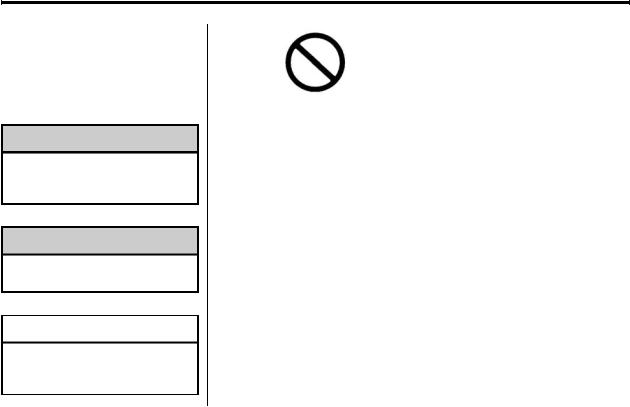
iv Introduction
Danger, Warnings, and
Cautions
Warning messages found on vehicle labels and in this manual describe hazards and what to do to avoid or reduce them.
{Danger
Danger indicates a hazard with a high level of risk which will result in serious injury or death.
{Warning
Warning indicates a hazard that could result in injury or death.
{Caution
Caution indicates a hazard that could result in property or vehicle damage.
A circle with a slash through it is a safety symbol which means “Do Not,” “Do not do this,” or “Do not let this happen.”
Symbols
The vehicle has components and labels that use symbols instead of text. Symbols are shown along with the text describing the operation or information relating to a specific component, control, message, gauge, or indicator.
M: This symbol is shown when you need to see your owner manual for additional instructions or information.
* : This symbol is shown when you need to see a service manual for additional instructions or information.
Vehicle Symbol Chart
Here are some additional symbols that may be found on the vehicle and what they mean. For more information on the symbol, refer to the Index.
9 : Airbag Readiness Light
! : Antilock Brake System (ABS)
% : Audio Steering Wheel Controls or OnStar® (if equipped)
$ : Brake System Warning Light
" : Charging System
I: Cruise Control
B : Engine Coolant Temperature
O: Exterior Lamps
# : Fog Lamps
. : Fuel Gauge
+ : Fuses
3 : Headlamp High/Low-Beam Changer
j : LATCH System Child Restraints

Introduction v
* : Malfunction Indicator Lamp
: : Oil Pressure
g : Outside Power Foldaway
Mirrors
} : Power
/: Remote Vehicle Start
> : Safety Belt Reminders
7 : Tire Pressure Monitor
_: Tow/Haul Mode
t : Traction Control/StabiliTrak®
M : Windshield Washer Fluid

vi Introduction
2 NOTES

In Brief |
1-1 |
In Brief
Instrument Panel
Instrument Panel . . . . . . . . . . . . . . 1-2
Initial Drive Information
Initial Drive Information . . . . . . . . 1-4
Remote Keyless Entry (RKE)
System . . . . . . . . . . . . . . . . . . . . . . 1-4
Remote Vehicle Start . . . . . . . . . 1-4
Door Locks . . . . . . . . . . . . . . . . . . . 1-5
Liftgate . . . . . . . . . . . . . . . . . . . . . . . . 1-5
Windows . . . . . . . . . . . . . . . . . . . . . . 1-6
Seat Adjustment . . . . . . . . . . . . . . 1-6
Memory Features . . . . . . . . . . . . . 1-7
Second Row Seats . . . . . . . . . . . 1-8
Third Row Seats . . . . . . . . . . . . . . 1-8
Heated and Cooled Front
Seats . . . . . . . . . . . . . . . . . . . . . . . . 1-9
Head Restraint Adjustment . . . . 1-9
Safety Belts . . . . . . . . . . . . . . . . . . . 1-9
Passenger Sensing
System . . . . . . . . . . . . . . . . . . . . . 1-10
Mirror Adjustment . . . . . . . . . . . . 1-10
Steering Wheel
Adjustment . . . . . . . . . . . . . . . . . 1-11
Interior Lighting . . . . . . . . . . . . . . 1-12
Exterior Lighting . . . . . . . . . . . . . 1-13
Windshield Wiper/Washer . . . . 1-13
Climate Controls . . . . . . . . . . . . . 1-14
Transmission . . . . . . . . . . . . . . . . 1-15
Vehicle Features
Radio(s) . . . . . . . . . . . . . . . . . . . . . 1-16
Satellite Radio . . . . . . . . . . . . . . . 1-17
Portable Audio Devices . . . . . . 1-18
Bluetooth® . . . . . . . . . . . . . . . . . . . 1-18
Steering Wheel Controls . . . . . 1-18
Cruise Control . . . . . . . . . . . . . . . 1-19
Forward Collision Alert (FCA)
System . . . . . . . . . . . . . . . . . . . . . 1-19
Lane Departure
Warning (LDW) . . . . . . . . . . . . . 1-19
Side Blind Zone
Alert (SBZA) . . . . . . . . . . . . . . . 1-19
Rear Vision
Camera (RVC) . . . . . . . . . . . . . 1-20
Rear Cross Traffic Alert
(RCTA) System . . . . . . . . . . . . 1-20
Parking Assist . . . . . . . . . . . . . . . 1-20
Power Outlets . . . . . . . . . . . . . . . 1-20
Universal Remote System . . . 1-20
Sunroof . . . . . . . . . . . . . . . . . . . . . . 1-21
Performance and Maintenance
Traction Control/Electronic Stability Control . . . . . . . . . . . . 1-21
Tire Pressure Monitor . . . . . . . . 1-22 Engine Oil Life System . . . . . . 1-22 Driving for Better Fuel
Economy . . . . . . . . . . . . . . . . . . . 1-22 Roadside Assistance
Program . . . . . . . . . . . . . . . . . . . . 1-23 OnStar® . . . . . . . . . . . . . . . . . . . . . 1-23
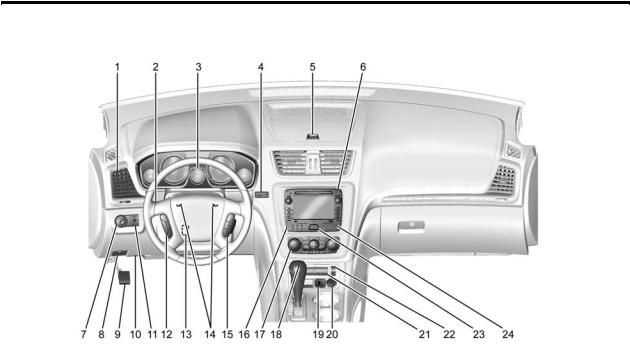
1-2 In Brief
Instrument Panel

In Brief |
1-3 |
1.Air Vents on page 8-11.
2.Windshield Wiper/Washer on page 5-3 (Out of View).
Turn Signal Lever. See Turn and Lane-Change Signals on
page 6-4.
3.Instrument Cluster on page 5-10.
4.Head-Up Display (HUD) on page 5-28 (If Equipped).
5.Instrument Panel Storage on page 4-1.
6.Infotainment on page 7-1.
7.Exterior Lamp Controls on page 6-1.
8.Hood Release. See Hood on page 10-4.
9.Parking Brake on page 9-27.
10.Data Link Connector (DLC) (Out of View). See Malfunction Indicator Lamp on page 5-15.
11.Dome Lamp Override. See
Dome Lamps on page 6-5.
Instrument Panel Illumination Control on page 6-5.
12.Cruise Control on page 9-30.
13.Steering Wheel Adjustment on page 5-2.
14.Horn on page 5-3.
15.Steering Wheel Controls on page 5-2 (If Equipped).
16.Driver Information Center (DIC) Buttons. See Driver Information Center (DIC) on page 5-23.
17.Climate Control Systems on page 8-1 or Dual Automatic Climate Control System on page 8-4 (If Equipped).
18.Shift Lever. See Automatic Transmission on page 9-22.
19.USB Port. See Auxiliary Devices on page 7-15.
20.Power Outlets on page 5-7.
21.Rear Window Wiper/Washer on page 5-4.
Traction Control/Electronic Stability Control on page 9-28.
Forward Collision Alert (FCA) System on page 9-33 (If Equipped).
Lane Departure Warning (LDW) on page 9-40 (If Equipped).
Tow/Haul Button (If Equipped). See Tow/Haul Mode on
page 9-25.
Power Liftgate Button (If Equipped). See Liftgate on page 2-8.
22.Heated and Cooled Front Seats on page 3-8 (If Equipped).
23.Hazard Warning Flashers on page 6-3.
24.Passenger Airbag Status Indicator. See Passenger Sensing System on page 3-29.
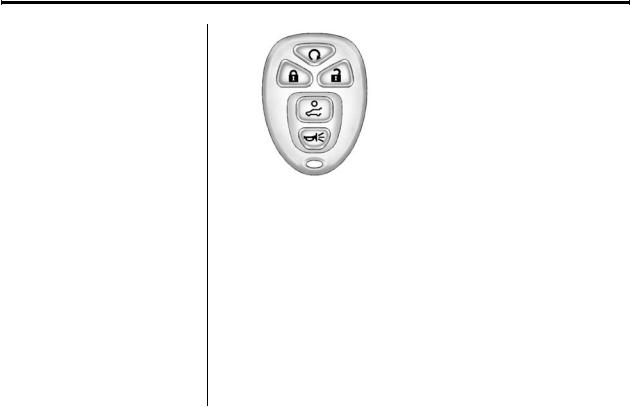
1-4 In Brief
Initial Drive
Information
This section provides a brief overview about some of the important features that may or may not be on your specific vehicle.
For more detailed information, refer to each of the features which can be found later in this owner manual.
Remote Keyless Entry
(RKE) System
The RKE transmitter is used to remotely lock and unlock the doors from up to 60 m (195 ft) away from the vehicle.
Press K to unlock the driver door.
Press K again within five seconds to unlock all remaining doors.
Press Q to lock all doors.
Lock and unlock feedback can be personalized.
To open or close the liftgate, press and hold 8until the liftgate begins to move.
Press L and release to locate the vehicle.
Press L and hold for more than two seconds to sound the panic alarm.
Press L again to cancel the panic alarm.
See Remote Keyless Entry (RKE) System Operation on page 2-2.
Remote Vehicle Start
Starting the Vehicle
If equipped, the engine can be started from outside of the vehicle.
1.Aim the RKE transmitter at the vehicle.
2.Press and release Q.
3.Immediately after completing Step 2, press and hold / until the parking lamps flash.
When the vehicle starts, the parking lamps will turn on and remain on as long as the engine is running. The doors will be locked and the climate control system may come on.
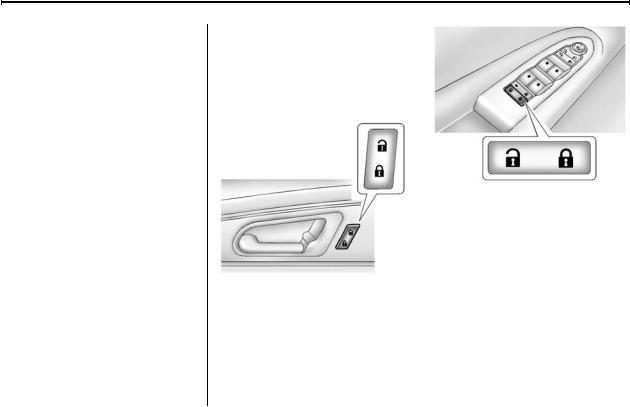
In Brief |
1-5 |
The engine will continue to run for 10 minutes. After 30 seconds, repeat the steps if a 10-minute extension is desired. Remote start can be extended only once.
Canceling a Remote Start
To cancel a remote start:
.Aim the RKE transmitter at the vehicle and press and hold / until the parking lamps turn off.
.Turn on the hazard warning flashers.
.Turn the ignition switch on and then off.
See Remote Vehicle Start on page 2-4.
Door Locks
To lock or unlock a door manually:
.From the inside use the door lock knob on the window sill.
.From the outside turn the key toward the front or rear of the vehicle, or press the K or Q button on the Remote Keyless Entry (RKE) transmitter.
Power Door Locks
Base Model
Uplevel Model
K : Press to unlock the doors.
Q : Press to lock the doors.
See Power Door Locks on page 2-6.
Liftgate
To open the liftgate the vehicle must be in P (Park). Press the touch pad under the liftgate handle and lift up. To close the liftgate, use the pull cup or pull strap as an aid.
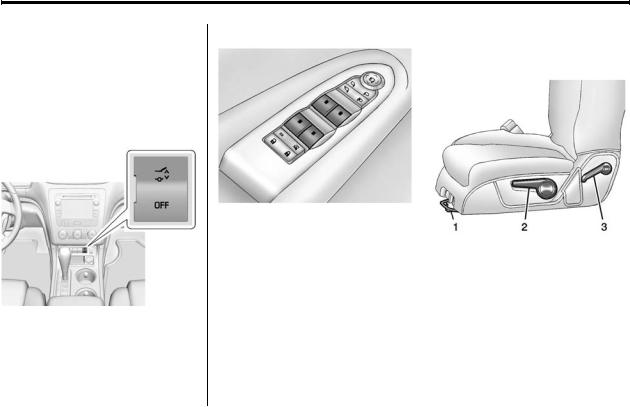
1-6 In Brief
Power Liftgate
If equipped with a power liftgate, the vehicle must be in P (Park) to operate it.
.Press and hold 8on the Remote Keyless Entry (RKE) transmitter.
.Press O.
.Press the touch pad on the outside liftgate handle.
See Liftgate on page 2-8.
Windows
Uplevel Shown, Base Similar
Press the switch to lower the window. Pull the switch up to raise it.
For more information, see Power Windows on page 2-17.
Seat Adjustment
Manual Seats
1.Seat Adjustment Handle
2.Driver Seat Height Adjustment Lever
3.Seatback Lever
To adjust a manual seat:
1.Lift the handle (1) under the seat to unlock it.
2.Slide the seat to the desired position, and then release the handle (1).
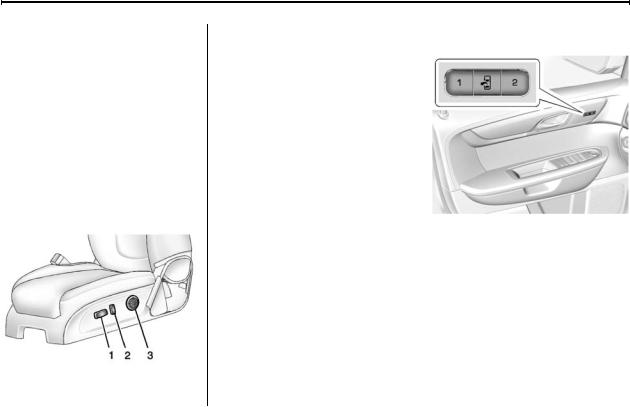
In Brief |
1-7 |
3.Try to move the seat back and forth to be sure it is locked in place.
Move the lever (2) up or down to raise or lower the seat.
Use the lever (3) to adjust the seatback.
See Seat Adjustment on page 3-3 and Reclining Seatbacks on page 3-5.
Power Seats
1.Seat Adjustment Control
2.Seatback Control
3. Lumbar Control
To adjust a power seat, if equipped:
.Move the seat forward or rearward by sliding the
control (1) forward or rearward.
.Raise or lower the front part of the seat cushion by moving the front of the control (1) up
or down.
.Raise or lower the entire seat by moving the rear of the control (1) up or down.
.Adjust the seatback by tilting the top of the control (2) forward or rearward.
See Reclining Seatbacks on page 3-5.
.Increase or decrease lumbar support by pressing the front or rear of the control (3).
See Lumbar Adjustment on page 3-4.
See Power Seat Adjustment on page 3-4.
Memory Features
If available, the controls on the driver door are used to program and recall memory settings for the driver seat, outside mirrors, and power steering column (if equipped).
See Memory Seats on page 3-6 and Vehicle Personalization on
page 5-42.
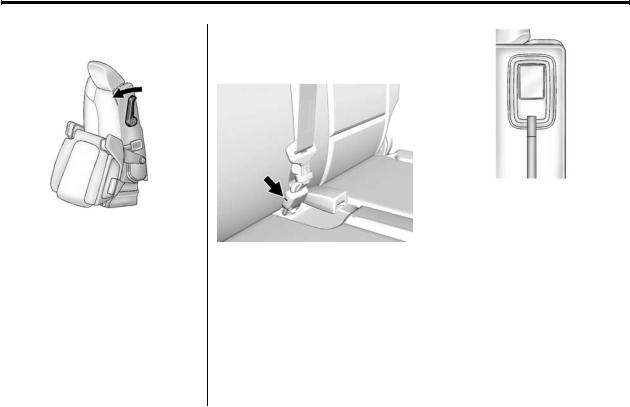
1-8 In Brief
Second Row Seats
The second row seat can be folded to access the third row. Pull the sliding seat lever forward; the seat cushion folds, and the seat slides forward.
See Rear Seats on page 3-9.
Third Row Seats
To fold the third row seatback:
1.Remove anything on or under the seat.
2.Disconnect the rear safety belt mini-latch using a key in the slot on the mini-buckle, and let the belt retract into the headliner. Stow the mini-latch in the holder in the headliner.
3.Pull up on the release lever on the back of the seat.
4.Push the seatback forward to lay flat.
See Third Row Seats on page 3-11.
The third row seatbacks can be folded forward, and the seats can be removed.
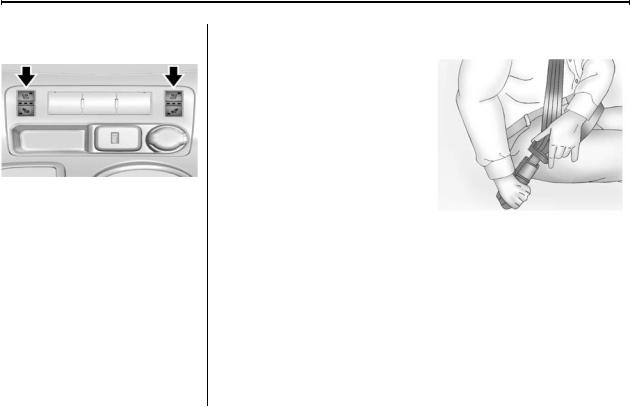
In Brief |
1-9 |
Heated and Cooled Front
Seats
Heated and Cooled Seat Buttons
Shown, Heated Seat Buttons
Similar
If equipped, the buttons are on the center stack. To operate, the engine must be running.
I : If equipped, press to heat the seatback only.
H : If equipped, press to cool the entire seat.
J : Press to heat the seat and seatback.
Press the button once for the highest setting. With each press of the button, the seat will change to the next lower setting, and then to the off setting. The lights indicate three for the highest setting and one for the lowest.
See Heated and Cooled Front Seats on page 3-8.
Head Restraint
Adjustment
Do not drive until the head restraints for all occupants are installed and adjusted properly.
To achieve a comfortable seating position, change the seatback recline angle as little as necessary while keeping the seat and the head restraint height in the proper position.
See Head Restraints on page 3-2 and Seat Adjustment on page 3-3.
Safety Belts
Refer to the following sections for important information on how to use safety belts properly:
.Safety Belts on page 3-14.
.How to Wear Safety Belts Properly on page 3-15.
.Lap-Shoulder Belt on page 3-16.
.Lower Anchors and Tethers for Children (LATCH System) on page 3-44.
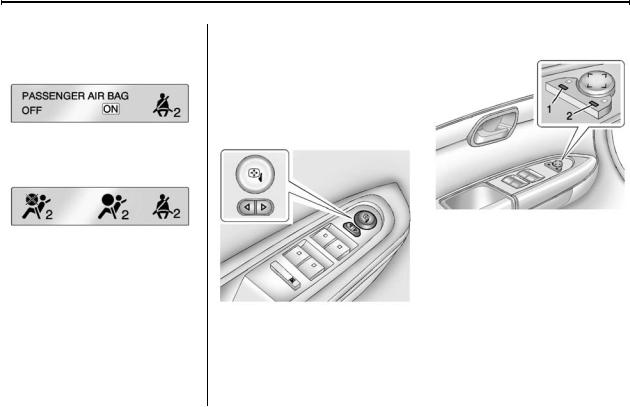
1-10 |
In Brief |
Passenger Sensing
System
United States
Canada and Mexico
The passenger sensing system will turn off the front outboard passenger frontal airbag under certain conditions. No other airbag is affected by the passenger sensing system. See Passenger Sensing System on page 3-29
The passenger airbag status indicator will light on the instrument panel when the vehicle is started. See Passenger Airbag Status Indicator on page 5-14.
Mirror Adjustment
Exterior Mirrors
Base Model
To adjust the mirrors:
1.Press o or p to select a mirror.
2.Press the control pad to adjust the mirror.
3.Return the switch to the center to deselect the mirror.
Uplevel Model
To adjust the mirrors:
1.Press (1) or (2) to select a mirror.
2.Press the control pad to adjust the mirror.
3.Press (1) or (2) again to deselect the mirror.
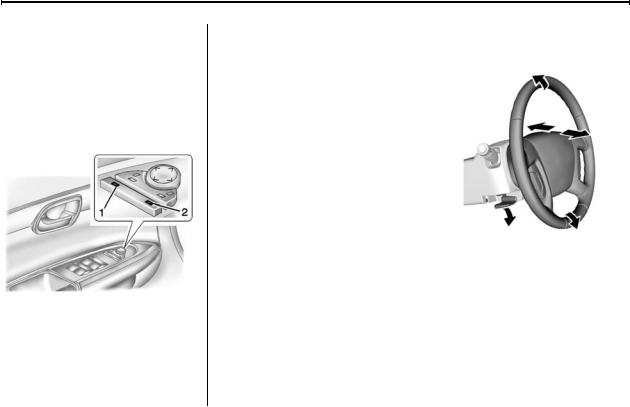
In Brief |
1-11 |
Folding Mirrors
For vehicles with manual folding mirrors, push the mirror toward the vehicle. Pull the mirror out to return to its original position.
For vehicles with power folding mirrors:
1.Press (1) to fold the mirrors out to the driving position.
2.Press (2) to fold the mirrors in to the folded position.
See Folding Mirrors on page 2-15.
Interior Mirror
Adjustment
Adjust the rearview mirror to clearly view the area behind the vehicle.
Manual Rearview Mirror
For vehicles with a manual rearview mirror, push the tab forward for daytime use and pull it for nighttime use to avoid glare from the headlamps from behind. See
Manual Rearview Mirror on page 2-16.
Automatic Dimming Rearview
Mirror
The mirror will automatically reduce the glare from the headlamps from behind. The dimming feature comes on when the vehicle is started. See
Automatic Dimming Rearview Mirror on page 2-17.
Steering Wheel
Adjustment
To adjust the steering wheel:
1.Pull the lever down.
2.Move the steering wheel up or down.
3.Pull or push the steering wheel closer or away from you.
4.Push the lever up to lock the steering wheel in place.
Do not adjust the steering wheel while driving.
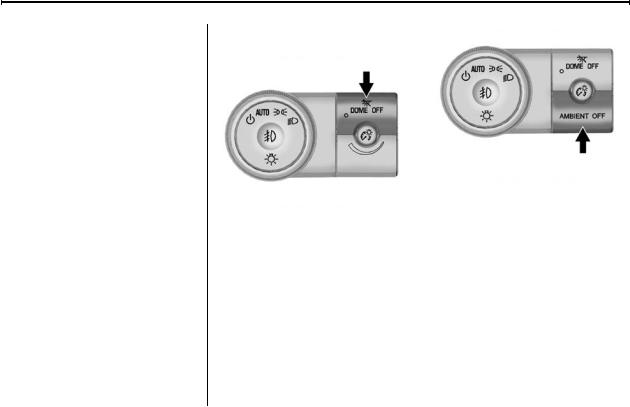
1-12 |
In Brief |
Interior Lighting
Dome Lamps
The dome lamps are in the overhead console and above the rear seat passengers.
The dome lamps come on when a door is opened, unless the dome lamp override button is pressed in.
To manually turn them on, turn the instrument panel brightness control clockwise to the farthest position.
Dome Lamp Override
The dome lamp override button is next to the exterior lamps control.
E DOME OFF: Press the button and the dome lamps remain off when a door is opened. An indicator light on the button comes on to show that the dome lamps are off. Press the button again so the dome lamps come on when a door is opened.
AMBIENT OFF (If Equipped):
Press the button to turn the ambient lights off. Press the button again to turn ambient lights on.
Reading Lamps
Press the button near each lamp to turn them on or off.
For more information, see:
.Dome Lamps on page 6-5.
.Instrument Panel Illumination Control on page 6-5.
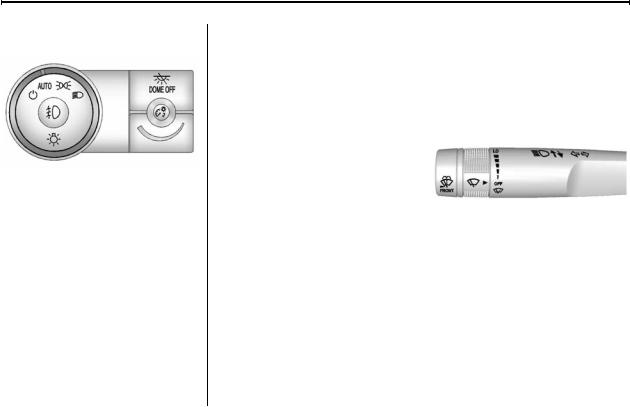
In Brief |
1-13 |
Exterior Lighting
The exterior lamp control is on the instrument panel, to the left of the steering wheel.
O : Briefly turn to this position to turn the automatic light control off or on again.
AUTO: Turns the headlamps on automatically at normal brightness, together with the other exterior lamps and instrument panel lights.
; : Turns on the parking lamps including all lamps, except the headlamps.
5 : Turns on the headlamps together with the parking lamps and instrument panel lights. A warning chime sounds if the driver door is opened when the ignition switch is off and the headlamps are on.
# : If equipped, it turns the fog lamps on or off.
See:
.Exterior Lamp Controls on page 6-1
.Fog Lamps on page 6-4
Windshield Wiper/Washer
The windshield wiper/washer lever is located on the left side of the steering column.
Turn the band with the wiper symbol to control the windshield wipers.
8 : Use for a single wiping cycle.
OFF: Use to turn the wipers off.
6 : Delays wiping cycle. Turn the band up for more frequent wipes or down for less frequent wipes.
LO: Slow wipes.
HI: Fast wipes.
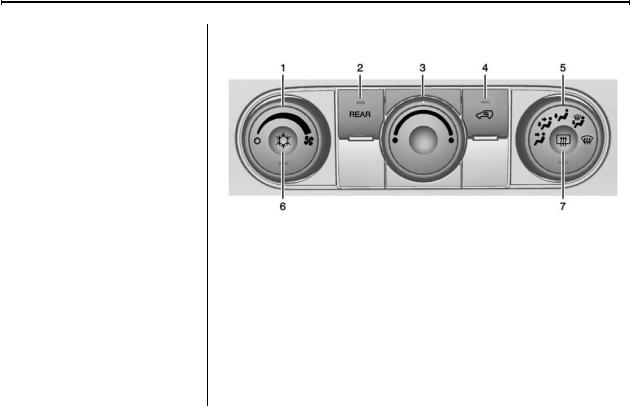
1-14 |
In Brief |
Windshield Washer
J FRONT: Press the button at the end of the lever to spray washer fluid on the windshield.
Rear Window Wiper/Washer
The rear wiper and rear wash button is on the center stack below the climate control system.
Z : Press to turn the rear wiper on and off. The wiper speed cannot be changed.
Y: Press to spray washer fluid on the rear window. The window wiper will also come on.
See Windshield Wiper/Washer on page 5-3 and Rear Window Wiper/ Washer on page 5-4.
Climate Controls
1. |
Fan Control |
5. |
Air Delivery Mode Control |
2. |
REAR (Rear Climate Control) |
6. |
Air Conditioning |
3. |
Temperature Control |
7. |
Rear Window Defogger |
4. |
Recirculation |
|
|
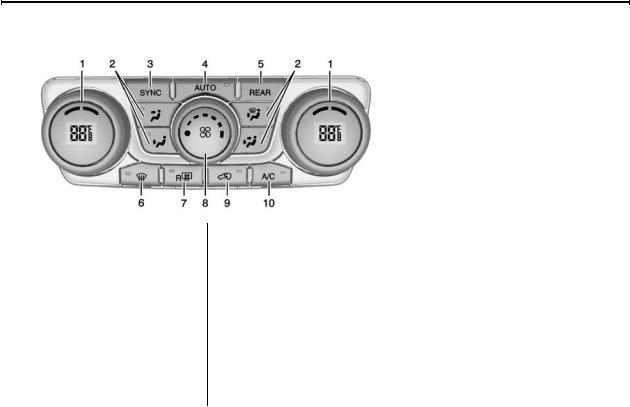
In Brief |
1-15 |
Dual Automatic Climate Control System
1.Driver and Passenger Side Temperature Controls
2.Air Delivery Mode Controls
3.SYNC (Synchronized Temperature)
4.AUTO (Automatic Operation)
5.REAR (Rear Climate Control)
6.Defrost
7.Rear Window Defogger
8.Fan Control
9.Recirculation
10.A/C (Air Conditioning)
See Climate Control Systems on page 8-1 or Dual Automatic Climate Control System on page 8-4 (If Equipped). For more information about the rear climate control, see
Rear Climate Control System on page 8-9 or Rear Climate Control System (with Rear Seat Audio) on page 8-10.
Transmission
Electronic Range Select
(ERS) Mode
ERS mode allows you to choose the top-gear limit of the transmission and the vehicle's speed while driving downhill or towing a trailer. The vehicle has an electronic shift position indicator within the instrument cluster. When using the ERS mode a number will display next to the L, indicating the current gear that has been selected.
To use this feature:
1.Move the shift lever to L (Low).
2.Press the plus/minus button on the shift lever, to increase or decrease the gear range available.
See Manual Mode on page 9-24.
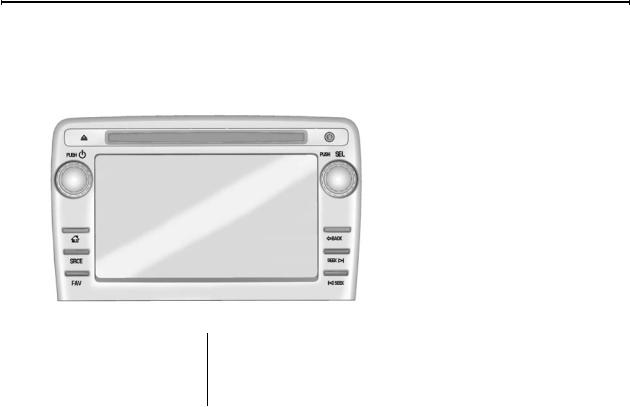
1-16 |
In Brief |
Vehicle Features
Radio(s)
PUSH/O : Press to turn the system on and off. Turn to adjust the volume.
Z : Press to eject a disc from the CD player. See CD Player on
page 7-11.
AUX Port: 3.5 mm (1/8 in) connection for external audio devices.
PUSH/SEL: Turn to manually find a station or highlight a menu selection. Press to select a highlighted selection.
D : Press to go to the Home Page. See “Home Page” in Operation on page 7-3.
SRCE: Press to change the audio source to AM, FM, SiriusXM® (if equipped), CD, USB, iPod®,
or AUX.
FAV: Press to display the favorite list or add a favorite. See Operation on page 7-3.
© SEEK or SEEK ¨ : Seek or scan stations and tracks. See Operation on page 7-3.
/ BACK: Press to return to the previous screen in a menu.

In Brief |
1-17 |
Storing Radio Station Presets
Up to 30 preset stations can be stored. AM, FM, and SiriusXM (if equipped) can be mixed.
1.From the AM, FM, or SiriusXM main page, press and hold any 1−5 buttons or one of the preset screen buttons at the bottom of the screen. After a few seconds, a beep is heard and the new preset information displays on that screen button.
2.Repeat for each preset.
See AM-FM Radio on page 7-6.
Setting the Clock
Press Settings on the Home Page, then press the Set Time or Set Date settings screen button to display the different options for setting the time and date.
Set Time:
.Press the up or down arrows to increase or decrease the Hours, Minutes, AM, PM, or 24 hr on the clock.
.Press and hold to quickly increase or decrease the time settings.
.Press OK or the Back screen button to save the adjustments that were made.
Set Date:
.Press the up or down arrows to increase or decrease the Month, Day, and Year settings.
.Press and hold to quickly increase or decrease the date settings.
.Press OK or the Back screen button to save the adjustments that were made.
Satellite Radio
If equipped, vehicles with a SiriusXM® satellite radio tuner and a valid SiriusXM satellite radio subscription can receive SiriusXM programming.
SiriusXM Satellite Radio
Service
SiriusXM is a satellite radio service based in the 48 contiguous United States and 10 Canadian provinces. SiriusXM satellite radio has a wide variety of programming and commercial-free music, coast to coast, and in digital-quality sound. A fee is required to receive the SiriusXM service.
Refer to:
.www.siriusxm.com or call 1-866-635-2349 (U.S.).
.www.xmradio.ca or call 1-877-209-0079 (Canada).
See Satellite Radio on page 7-9.

1-18 |
In Brief |
Portable Audio Devices
The vehicle has a 3.5 mm (1/8 in) auxiliary input jack on the faceplate and a USB port in the center stack. External devices such as iPods, laptop computers, MP3 players, CD changers, USB storage devices, etc. can be connected to the auxiliary port using a 3.5 mm (1/8 in) input jack or the USB port depending on the audio system.
If equipped, there are two USB ports on the rear of the center console that can be used for charging only. They can charge devices that draw 2.1 amps or less. See the device’s owner manual for the specification.
See Auxiliary Devices on page 7-15.
Bluetooth®
The Bluetooth® system allows users with a Bluetooth-enabled mobile phone to make and receive hands-free calls using the vehicle audio system and controls.
The Bluetooth-enabled mobile phone must be paired with the in-vehicle Bluetooth system before it can be used in the vehicle. Not all phones will support all functions.
See Bluetooth on page 7-18.
Steering Wheel Controls
w or c /x : Press to change favorite radio stations, select tracks on a CD, or navigate tracks or folders on an iPod or USB device.
b /g : Press to interact with Bluetooth and OnStar®, if equipped.
c /x : Press to reject an incoming call, or end a current call.
SRCE: Press to switch between AM, FM, CD, and if equipped, SiriusXM®, front auxiliary, rear auxiliary, and iPod/USB.
Press and hold to mute/pause the system.
¨ : Press to seek the next radio station, track, or chapter while sourced to the CD slot, or to select tracks and folders on an iPod or USB device.
+ e or − e : Press to increase or to decrease the volume.
See Steering Wheel Controls on page 5-2.
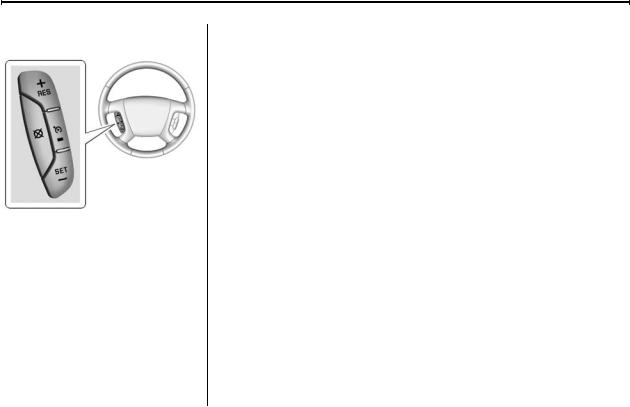
In Brief |
1-19 |
Cruise Control
T: Press to turn cruise control on or off. The indicator light on the button comes on when the cruise control is on.
+RES: If there is a set speed in memory, press briefly to resume to that speed or press and hold to accelerate. If cruise control is already active, use to increase vehicle speed.
SET–: Press briefly to set the speed and activate cruise control. If cruise control is already active, use to decrease vehicle speed.
[ : Press to disengage cruise control without erasing the set speed from memory.
See Cruise Control on page 9-30.
Forward Collision Alert
(FCA) System
If equipped, FCA may help avoid or reduce the harm caused by front-end crashes. FCA provides a
green indicator, V, when a vehicle is detected ahead. This indicator displays amber if you follow a vehicle much too closely. When approaching a vehicle ahead too quickly, FCA provides a red flashing alert on the windshield and rapidly beeps.
See Forward Collision Alert (FCA) System on page 9-33.
Lane Departure
Warning (LDW)
If equipped, LDW may help avoid unintentional lane departures at speeds of 56 km/h (35 mph) or greater. LDW uses a camera sensor to detect the lane markings. The
LDW light, @, is green if a lane marking is detected. If the vehicle departs the lane, the light will change to amber and flash. In addition, beeps will sound.
See Lane Departure Warning (LDW) on page 9-40.
Side Blind Zone
Alert (SBZA)
If equipped, SBZA will detect vehicles in the next lane over in the vehicle's side blind zone area. When this happens, the SBZA display will light up in the corresponding outside side mirror and will flash if the turn signal is on.
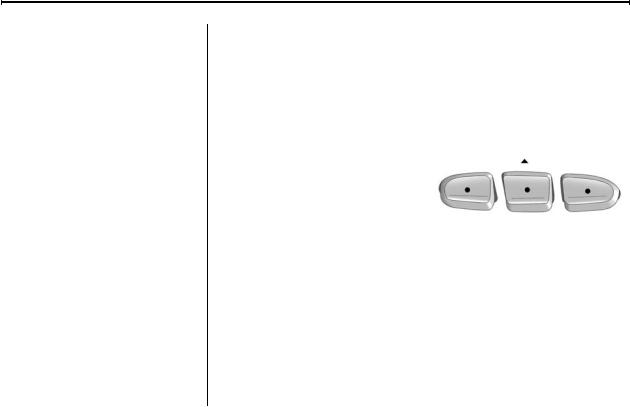
1-20 |
In Brief |
See Side Blind Zone Alert (SBZA) on page 9-36.
Rear Vision
Camera (RVC)
If equipped, RVC displays a view of the area behind the vehicle, on the center stack display, when the vehicle is shifted into R (Reverse).
See Rear Vision Camera (RVC) on page 9-38.
Rear Cross Traffic Alert
(RCTA) System
If equipped, the RCTA system uses a triangle with an arrow displayed on the RVC screen to warn of traffic behind your vehicle that may cross your vehicle's path while in
R (Reverse). In addition, beeps will sound.
See “Rear Cross Traffic Alert (RCTA)” under Rear Vision Camera (RVC) on page 9-38.
Parking Assist
If equipped, this system uses sensors on the rear bumper to assist with parking and avoiding objects while in R (Reverse).
It operates at speeds less than
8 km/h (5 mph). Rear Parking Assist (RPA) uses audible beeps to provide distance and system information.
Keep the sensors on the vehicle's rear bumper clean to ensure proper operation.
See Parking Assist on page 9-35.
Power Outlets
The vehicle has 12-volt accessory power outlets, which can be used to plug in electrical equipment, such as a cell phone or MP3 player.
The power outlets are located:
.On the center stack below the climate controls.
.Inside the center console.
.At the rear of the center console.
.In the rear cargo area.
To use the outlets, remove the cover.
See Power Outlets on page 5-7.
Universal Remote System
If equipped, the Universal Home Remote System allows for garage door openers, security systems, and home automation devices to be programmed to work with these buttons in the vehicle.
See Universal Remote System on page 5-49.
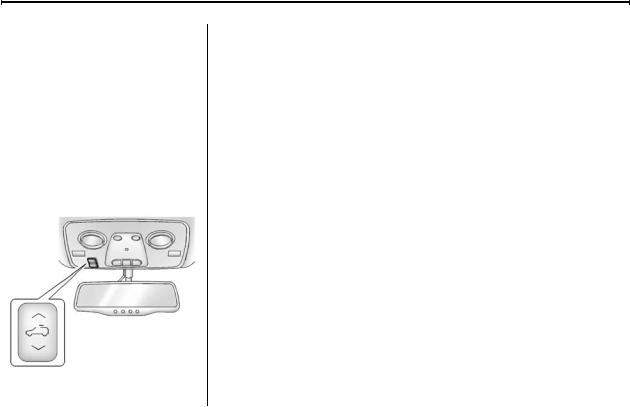
In Brief |
1-21 |
Sunroof
The ignition must be in ON/RUN or ACC/ACCESSORY, or Retained Accessory Power (RAP) must be active to operate the sunroof and power sunshade. See Retained Accessory Power (RAP) on
page 9-19.
The vehicle may have a sunroof over the front seats and a rear sunroof over the second row seats. The rear sunroof does not open.
Vent: Press the front or rear of the switch to vent or close the sunroof.
Express-open/Express-close:
Press and release the rear or front of the switch to express-open or express-close the sunroof.
Manual Sunshade
The sunshades must be opened and closed manually. To open the sunshade, press the button on the sunshade handle to release it and guide it back. To close the sunshade, pull the sunshade forward until it latches.
See Sunroof on page 2-19.
Performance and
Maintenance
Traction Control/
Electronic Stability
Control
The vehicle has a traction control system that limits wheel spin, and the StabiliTrak system that assists with directional control of the vehicle in difficult driving conditions. Both systems turn on automatically every time the vehicle is started.
.To turn off traction control and StabiliTrak, press and release 4 on the center stack, and the appropriate DIC message displays. See Ride Control System Messages on page 5-38.
.Press and release 4 again to turn on both systems.
See Traction Control/Electronic Stability Control on page 9-28.

1-22 |
In Brief |
Tire Pressure Monitor
This vehicle may have a Tire Pressure Monitor System (TPMS).
The low tire pressure warning light alerts to a significant loss in pressure of one of the vehicle's tires. If the warning light comes on, stop as soon as possible and inflate the tires to the recommended pressure shown on the Tire and Loading Information label. See
Vehicle Load Limits on page 9-9. The warning light will remain on until the tire pressure is corrected.
The low tire pressure warning light may come on in cool weather when the vehicle is first started, and then turn off as the vehicle is driven. This may be an early indicator that the
tire pressures are getting low and the tires need to be inflated to the proper pressure.
The TPMS does not replace normal monthly tire maintenance. Maintain the correct tire pressures.
See Tire Pressure Monitor System on page 10-46.
Engine Oil Life System
The engine oil life system calculates engine oil life based on vehicle use and displays the CHANGE ENGINE OIL SOON message when it is time to change the engine oil and filter.
The oil life system should be reset to 100% only following an oil change.
Resetting the Oil Life System
1.Turn the ignition to ON/RUN, with the engine off.
2.Press the vehicle information button until OIL LIFE REMAINING displays.
3.Press and hold the set/reset button until “100%” is displayed. Three chimes sound and the CHANGE ENGINE OIL SOON message goes off.
4.Turn the key to LOCK/OFF.
See Engine Oil Life System on page 10-9.
Driving for Better Fuel Economy
Driving habits can affect fuel mileage. Here are some driving tips to get the best fuel economy possible.
.Avoid fast starts and accelerate smoothly.
.Brake gradually and avoid abrupt stops.
.Avoid idling the engine for long periods of time.
.When road and weather conditions are appropriate, use cruise control.

In Brief |
1-23 |
.
.
.
.
.
Always follow posted speed limits or drive more slowly when conditions require.
Keep vehicle tires properly inflated.
Combine several trips into a single trip.
Replace the vehicle's tires with the same TPC Spec number molded into the tire's sidewall near the size.
Follow recommended scheduled maintenance.
Roadside Assistance
Program
U.S.: 1-888-881-3302
TTY Users (U.S. Only): 1-888-889-2438
Canada: 1-800-268-6800
New GMC owners are automatically enrolled in the Roadside Assistance Program.
See Roadside Assistance Program on page 13-5.
OnStar®
This vehicle may be equipped with a comprehensive, in-vehicle system that can connect to a live OnStar Advisor for Emergency, Security, Navigation, Connection, and Diagnostic Services. OnStar services may require a paid subscription. See OnStar Overview on page 14-1.
